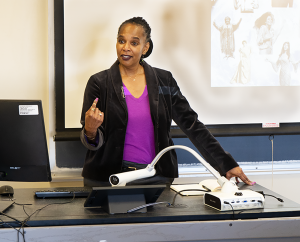
Maya Gibson places Black history and music center stage in “Black Women in Music,” an Honors course covering Black female musicians from Ma Rainey to Beyoncé.
Gibson, who is originally from the Washington, D.C., area, attended Oberlin College in Ohio and received degrees in vocal performance, English literature and Black studies. She pursued two master’s degrees at the University of Wisconsin-Madison – African American studies and music history. Gibson came to Mizzou 12 years ago and eventually found her place in the Honors College. Gibson is part of a growing Honors faculty cohort who are teaching classes on subjects they’re passionate about. She saw a space for celebrating the history of Black female musicians and took the leap.

“I love to tell the story of Black music, focusing on Black women as representatives,” Gibson says. Gibson also teaches a section of the Honors Humanities Sequence, and she maps the stories the sequence explores onto the musicians “Black Women in Music” celebrates. “The focus on narrative, the way humans tell stories … the history of these women maps pretty well onto the kinds of stories we tell.”
If there is one musician she favors, it is by far Billie Holliday, having written her dissertation on the iconic jazz singer. Gibson says the topic was an “integral part” of her life.
“I’ve wanted to teach the class since, surely, graduate school. It’s something I’ve dreamt of doing,” Gibson says. “(Holiday) keeps getting reworked by academics and scholars. I find her strikingly real and beautiful. I could have written a book.”
The class is currently in its rock ’n’ roll unit and is covering Tina, a 2021 documentary about the life and career of the late Tina Turner, who dominated the rock scene in the 1980s. The class will also watch documentaries about Donna Summer, disco icon; Poly Styrene, one of punk rock’s UK founders; and Beyoncé’s video album Lemonade. The class is heavily discussion-based.
Gibson starts from the foundations of the soundscape and builds up, stacking each genre and its descendants until they reach the present day. Blues to gospel, gospel to jazz, jazz to soul, soul to disco, disco to R&B, punk, hip-hop, rap, metal; the class covers almost 130 years of music history.
“I love each artist because each builds on each other; they’re all successors,” Gibson says. “I love it when students are able to make that connection. To look at Poly Styrene, in punk music, and see her roots in the blues musicians of the 1920s, it’s very rewarding.”
In the future, Gibson hopes the class will adapt to the changing landscape of music and hopes the class will branch out. Currently, the course is confined to one semester, and with the size of the soundscape of Black female musicians, Gibson feels the present scope is limited.
“I really try to center the lives of Black women,” Gibson says. “So often when we tell the story of Western music history, it’s as if Black women are in the periphery. I want to see what we learn from this perspective.”